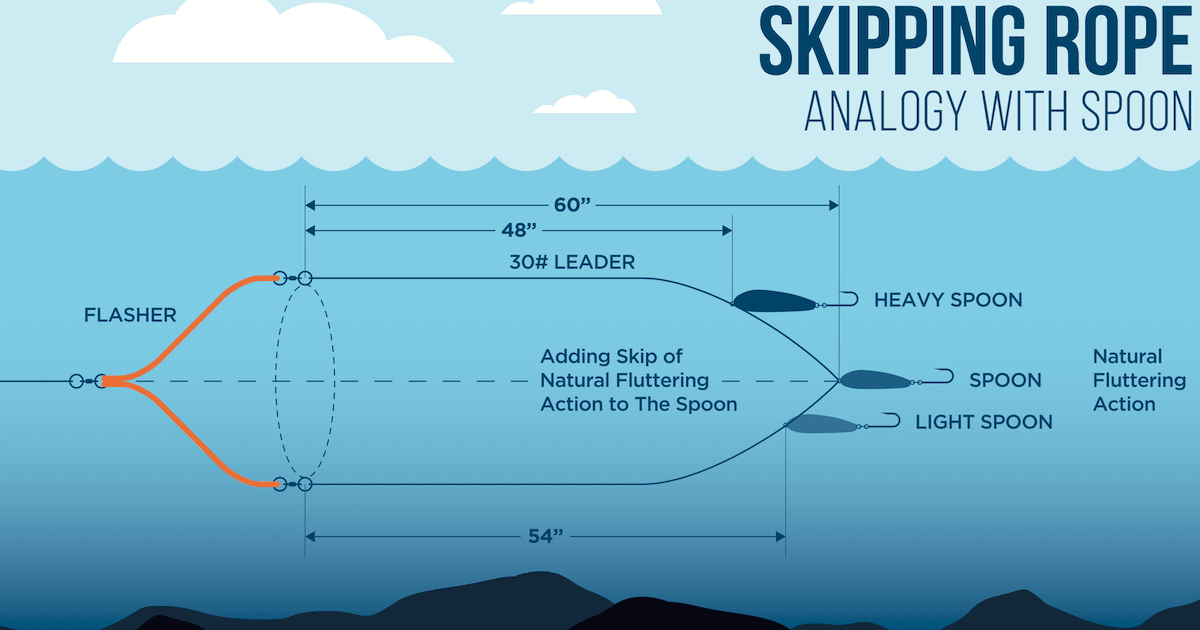
Some anglers think it’s crazy (or at least unusual) to run a flasher in line with a spoon. Most would just run a dummy flasher at the cannonball and fish the spoon by itself, or just fish the spoon by itself off the downrigger without a flasher. But all of these setups work fine, and each has its advantages. The spoon is imitating wounded or frantic bait swimming in the ocean, which attracts fish to feast on it. The flasher’s main job is to attract fish to the spoon. I normally fish with flasher and spoon during the winter and spring, just because there is sometimes not much bait around. There are two ways to set up flasher and spoon fishing; let’s take a look at what the flasher does for a spoon when paired together these different ways.
A flasher in line with a spoon attracts fish or adds slight action to the spoon. The main job of a flasher is to attract fish with the reflected light spectrum and the vibration it creates in the water. Most anglers will run long leaders and have the spoon far back from the standard rectangle flasher.
Spoon and Flasher Combination for BC Salmon
This way the flasher will not affect the natural action of the spoon. I find a 72-in long leader (away from the flasher) is a good length to start with. You can also use an agitator flasher in line with a spoon. It just spins like a prop and will not affect the spoon’s action, which means you can use whatever leader length and leader test for this setup. I run small/narrow spoons on a 48-in leader with the agitator flasher.
Salmon Fishing Agitator
With the rectangular flasher creating that whipping action on the fishing line, you can add slight action to the spoon. Think of the leader line like a skipping rope between the flasher and spoon.
The closer to the halfway mark of the skipping rope, the more whipping action the spoon will have, making the spoon skip a beat on the natural flutter. I find a 48- to 60-in leader works well, depending what test leader line you fish with your spoon. I tend to fish with 60-in long leader and 30-lb test while fishing with lightweight spoons (like Skinny G, Coyote 3.5, and Kingfisher). I try to have the spoon as close to the flasher as possible so the whipping action from the flasher affects the spoon fluttering action. I would increase the leader length if you increase the leader test,because stiffer leader line can transfer more action from the flasher. (See illustration at the top of this article.)
Fighting the fish on a spoon without the flasher drag in the water is fun. Another effective setup is to run a dummy flasher off the cannonball and fish a spoon off the downrigger clip.
Agitator on Cannonball
The things to watch out for in this setup are the distance between your flasher and the downrigger clip, and how far back your spoon is from the dummy flasher. First of all, the leader length of your dummy flasher will dictate the distance between your downrigger clip and the dummy flasher. If you have a 12-in long leader before attaching your flasher, then you need a minimum of 3 ft apart from the clip. This gap is required because it will prevent your clip and flasher getting tangled when dropping the rig down to the fishing depth. I typically run a dummy flasher off the cannonball and have the release clip 3 ft above, but if I run a 12-in leader line for a dummy flasher, then I keep them 5 ft apart. Now, how far back do you run the spoon behind the dummy flasher? This length is just preference. I run it 3 to 10 ft behind the dummy flasher. The point of the dummy flasher is to attract fish to your spoon. I believe that if your spoon is too close to the flasher, the flasher, and not the spoon, will get the fish’s attention. I run the 5- to 7-in spoons 8 ft back from the flasher, and the 3- to 5-in spoons between 3 and 8 ft back. Sometimes the fish are flasher-shy; they prefer the spoon further back behind the dummy flasher—say, 15 feet. Try it out and find lengths that work best with your spoons.
Dummy Flasher Setup when fishing with spoons
Both of these setups have caught me salmon, lingcod, and rockfish. The trolling speed for both depends on the spoon action that you are looking for. Typically, I like 1.5 to 3 knots or 30 to 45 degrees on the downrigger cable. I prefer running Tom Mack, P3C, Gibbs, Silver Horde, Coyote, Lighthouse, and Pesca spoons behind an inline flasher. I prefer AP Tackleworks, Tomic, Blue Fox Matrix, and Lucky Strike Canoe spoons behind a dummy flasher, just because they are heavier. Try both setups and see what you prefer.
This article appeared in Island Fisherman Magazine. Never miss another issue—subscribe today!
Visit the Store
$34.99
$34.99
Featured Catch
Joel Unickow halibut (Photo: Rob Frawley Lucky Strike Sportfishing Tofino)



